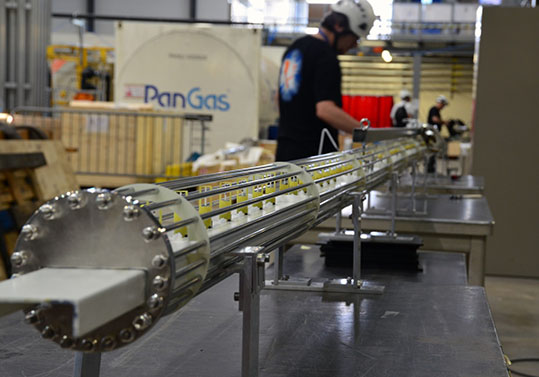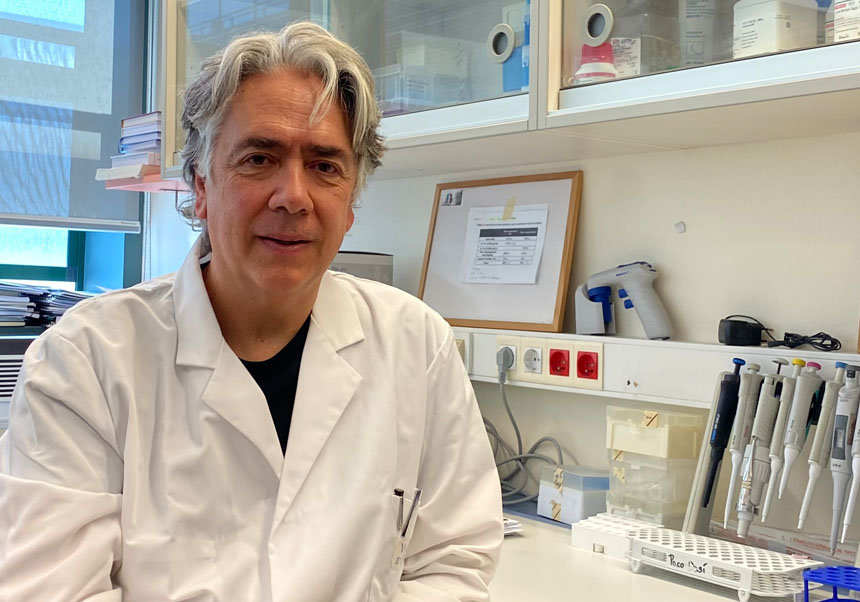The IFIC develops the most precise ‘thermometer’ in the world for particle physics experiments
- Fundacions i entitats associades
- July 11st, 2018

Scientists from the Instituto de Física Corpuscular (a mixed research centre of the Universitat de València and the CSIC) install an extremely sensitive system in the CERN to mesure the temperature of the ProtoDune, a DUNE large-scale prototype, one of the biggest experiments on neutrino physics in the world. It the biggest and the most precise thermometer that has been created for particle physics experiments.
Particle physics experiments are the science’s Olympics: they require more than mere technology. Instead of the Latin ‘citius, altius, fortius’ (faster, higher, stronger), these experiments, trying to find out what the Universe is made of, must be the biggest and the most precise of their kind. Two large-scale prototypes of one of the biggest experiments on neutrino physics in the world are being built at the CERN. In order to operate, they require tons of liquid argon, whose temperature must be homogenous. To make that work, a team from the Instituto de Física Corpuscular (IFIC) –the Severo Ochoa Centre of Excellence in the Universitat de València and the CSIC, in the university’s Science Park– have develop a tool that measures the temperature with a precision of three thousandths of a degree.
ProtoDune consists of two separate eight-meter-high cube-shaped containers that contain 800 tons of liquid argon each, where very precise detectors able to see the passing charged particles in 3D are immersed. The containers are located in Geneva and they serve to prove the technology that will be used in DUNE, an experiment that will be carried out in the United States during the next decade and that will use the most powerful neutrino beam in the world in order to study neutrino, the most elusive, fundamental, and mysterious particle of all.
Argon, a gas at ambient temperature, becomes liquid at 184º C below zero. To make this happen, the biggest cryostat created so far, with a 500,000 litre inner volume, have been built. Even though, it is not enough to keep liquid argon: the detector’s proper operation demands under two hundredths of a degree temperature variations inside the cryostat, which is a minuscule difference for such big volume.
To control that, a very precise system of temperature measurement, already developed by some scientists and technics in the IFIC, is needed. It is a fiberglass structure of almost 8 metres high where 48 platinum sensors calibrated at the IFIC are inserted so that a temperature precision of up to two thousandths of a degree are reached. The structure is encircled by a Faraday cage, which protects the system from the huge electric field (70,000 volts) nearby.
“This is the biggest and the most precise temperature measurement system that has been developed for this kind of particle physics experiments”, Anselmo Cervera Villanueva, CSIC’s head scientist and responsible for its development, maintains. The cryogenic system of the Large Hadron Collider (LHC), which delivers superfluid helium at -271.3ºC through the accelerator ring to refrigerate the superconducting magnet, does not require that precision level.
CERN itself is the responsible of the ProtoDUNE cryogenic system and the two prototype cryostats, being crucial its collaboration with the IFIC for the temperature measurement system development, which was installed in late June.
The system is included in the IFIC’s contribution to the DUNE experiment, where more than 1,000 scientists from 175 institutions in 32 countries collaborated together with the CERN. Besides developing the temperature monitoring system of at least the two first DUNE’s detectors –there are 4 planned–, containing each 10,000 tons of liquid argon, the IFIC experimental team coordinates the control of the rest of cryostat parameters. Furthermore, the IFIC has coordinated a work team in DUNE to measure proton decay by studying the experiment’s sensitiveness to observe this undetected process. It also develops tool for DUNE data and its prototypes analysis as well as the design and future installation of the light detection system of one of the big containers in the experiment.
The Institute (IFIC) also performs simulations of the DUNE’s capacity to determine parameters still unknown, such as the one that codifies the possible difference in behaviour between neutrinos and antineutrinos – a key to understand why the Universe is made of matter and antimatter. DUNE will study the neutrino beams interactions sent with unprecedented intensity and precision from Fermilab (close to Chicago) until the subterranean lab in Sanford (South Dakota) in order to understand the changes in these particles when they go very quickly from one point to the other (1,300 km). This will allow the finding of answers for fundamental question in nowadays physics.
Besides fully studying the oscillations among the three known neutrino types, which is the change that they suffer while travelling through space, DUNE will check the existence of another type of neutrino, heavier but with weaker interactions when compared the ones of the known neutrinos. This type is known as ‘sterile neutrino’. DUNE could also find out the nature of the mysterious particles that form the dark matter in the Universe, which could produce together with neutrinos in the beam produced in Fermilab and could be discovered in a closer detector. It could also observe the neutrinos produced in stellar explosions (supernovas), revealing the neutron stars and black holes’ formation, and will also investigate if protons live forever or if they disintegrate in other particles, being closer to Einstein’s dream: Grand Unification Theory.
















